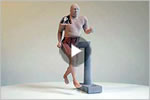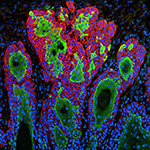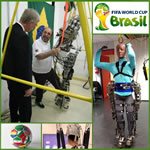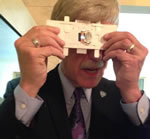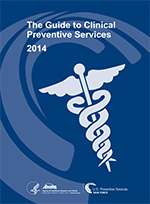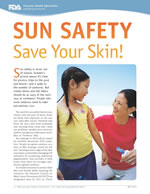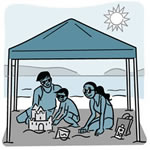Spotlight
Letter from Dr. Stephen I. Katz: Celebrating a Decade of Discovery With the Common Fund and PROMIS
This year marks the 10th anniversary of the National Institutes of Health (NIH) Common Fund. Launched in 2004 as the NIH Roadmap for Medical Research, and later renamed the Common Fund, this effort supports programs designed to change the way science is conducted—through the establishment of new scientific fields or paradigms, the development of novel approaches to how scientists conduct their work or the generation of resources that catalyze research and enable discovery. In honor of this important milestone [PDF - 8.8MB], my letter this month focuses on the NIH Common Fund and the Patient-Reported Outcomes Measurement Information System (PROMIS), an important program in which the NIAMS has played a leading role.
Image: Stephen I. Katz, M.D., Ph.D.
News
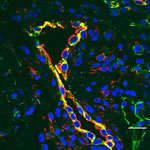 NIH Scientists Identify Gene Linked to Fatal Inflammatory Disease in Children
NIH Scientists Identify Gene Linked to Fatal Inflammatory Disease in Children
Investigators at the NIAMS have identified a gene that underlies a very rare but devastating autoinflammatory condition in children. Several existing drugs have shown therapeutic potential in laboratory studies, and one is currently being used in children with the disease, which the researchers named STING-associated vasculopathy with onset in infancy (SAVI). The findings appeared online in the New England Journal of Medicine.
Image: Blood vessels (yellow) in SAVI become inflamed (red). Credit: Manfred Boehm, M.D., NHLBI.
 Kayla’s Story: A Bright Future Through NIH Research (Video)
Kayla’s Story: A Bright Future Through NIH Research (Video)
Neonatal onset multisystem inflammatory disease (NOMID) is a rare but devastating autoinflammatory disease that begins in infancy. The NIAMS has produced a new video describing how a NIAMS researcher discovered an effective treatment for it, allowing Kayla and other children with the condition to live a normal life, with an excellent prognosis.
New Report Offers a Primer for Doctors’ Use of Clinical Genome and Exome Sequencing
Sooner than almost anyone expected, a new, genome-based technology for demystifying undiagnosed illnesses—particularly rare childhood diseases—is moving from research laboratories into general medical practice. Now, two leading scientists have sketched out what doctors need to know in order to use the new technology effectively.
NIH Launches 3D Print Exchange for Researchers, Students: Public Website Promotes Health and Science Applications of 3D Printing
The NIH has launched the NIH 3D Print Exchange, a public website that enables users to share, download and edit 3D print files related to health and science. These files can be used, for example, to print custom laboratory equipment and models of bacteria and human anatomy. The launch coincides with the first White House Maker Faire, an event designed to celebrate U.S. innovation in science, technology, engineering and math.
Image: The NIH 3D Print Exchange is a free online library of 3D print files related to health and science.
From Lab Bench to Bedside: Accelerating the Commercialization of Biomedical Innovations
We are delighted to announce a new collaboration between the NIH and the National Science Foundation to empower entrepreneurial scientists and advance the Lab-to-Market priorities set forth in the President’s Management Agenda [PDF - 112KB]. The federal government invests over $130 billion on research and development each year, and the President’s 2015 budget supports a sustained commitment to accelerate the transfer of promising federally funded technologies from the laboratory to the commercial marketplace.
New NIH Council of Councils Members Named
The NIH announced the appointment of nine individuals to the NIH Council of Councils. The council was established to advise the NIH Director on policies and activities of the Division of Program Coordination, Planning and Strategic Initiatives, including making recommendations on research that represents important areas of emerging scientific opportunities, rising public health challenges or knowledge gaps that deserve special emphasis or would otherwise benefit from strategic planning and coordination.
New Efforts To Maximize Fairness in NIH Peer Review
We want you to know the NIH is working on multiple fronts to get to the bottom of unexplained racial disparities in R01 grant funding and to maximize fairness in NIH peer review. Since the problems and the solutions are bigger than the NIH, we have reached out to the scientific community and other concerned citizens for help. Now armed with a team of experts and a set of new initiatives, we’d like to tell you about our efforts to address this important issue—particularly an exciting opportunity for you to submit your input.
NIH Director’s Blog
Snapshots of Life: Portrait of Skin Cancer
For Markus Schober, science is more inspiring when the images are beautiful, even when the subject is not. So, when this biologist was at the Rockefeller University in New York and peered through his microscope at squamous cell carcinoma (SCC), both the diabolical complexity and the beauty of this common form of skin cancer caught his eye.
Image: Uncontrolled growth of cells in SCC. Credit: Markus Schober & Elaine Fuchs, Rockefeller U. NY
Neuroscience Research Kicks Off World Cup
More than a billion people all around the globe got their first look at cutting-edge neuroscience research in action when a paraplegic youth wearing a thought-controlled, robotic exoskeleton kicked a ball to launch the 2014 FIFA World Cup opening ceremony in São Paulo, Brazil. While much work remains before this or similar devices become widely available to people with paralysis, this moment does provide an inspiring glimpse of just one of the many things that can be achieved when science is supported over the long haul.
Image: NIH Director Dr. Francis S. Collins with neuroscientist Miguel Nicolelis and the device unveiled at the FIFA World Cup opening ceremony. Credits: Fogarty International Center, FIFA World Cup, Walk Again Project
Print-and-Fold Origami Microscope for 50 Cents
When Stanford University bioengineer Manu Prakash traveled to a mosquito-infested rainforest in Thailand a couple of years ago, he visited a clinic with a sophisticated, $100,000 microscope that sat unused in a locked room. It was then Prakash realized that what global health workers really need is an ultra-low-cost, simple-to-use, portable microscope that could be deployed in the field to diagnose disease—and he took it upon himself to develop one!
Image: NIH Director Dr. Francis S. Collins checks out the Foldscope at the White House Maker Faire on June 18. Credit: Manu Prakash, Stanford
Formula for Innovation: People + Ideas + Time
In these times of tight budgets and rapidly evolving science, we must consider new ways to invest biomedical research dollars to achieve maximum impact—to turn scientific discoveries into better health as swiftly as possible. We do this by thinking strategically about the areas of research that we support, as well as the process by which we fund that research.
Other Federal News
 Mind and Body Practices for Fibromyalgia
Mind and Body Practices for Fibromyalgia
Fibromyalgia syndrome is a common and chronic disorder characterized by widespread pain, diffuse tenderness, fatigue and a number of other symptoms that can interfere with a person’s ability to carry out daily activities. It is estimated that fibromyalgia affects 5 million American adults. Most people with fibromyalgia—between 80 and 90 percent—are women. However, men and children also can have the disorder, which is often associated with other syndromes. The causes of fibromyalgia are unknown, but there are probably a number of factors involved. Recently, researchers have focused on abnormalities in processing of pain by the central nervous system.
Topical Acne Products Can Cause Dangerous Side Effects
Certain acne treatments can, in rare instances, cause severe allergic reactions that are potentially life-threatening. The U.S. Food and Drug Administration (FDA) is warning that the use of certain acne products containing the active ingredients benzoyl peroxide or salicylic acid can cause rare but serious and potentially life-threatening allergic reactions or severe irritation. An active ingredient is the component that makes the medicine effective against the illness or condition it is treating.
Juvenile Arthritis: New Discoveries Lead to New Treatments
Arthritis is a disease that mostly affects older people, right? Not necessarily. Juvenile arthritis is one of the most common chronic illnesses affecting children. In fact, nearly 300,000 youngsters nationwide have been diagnosed with the disease. The most common symptoms include joint pain, inflammation (swelling), tenderness and stiffness. One early sign may be limping in the morning.
FDA Blueprint for Helping Children With Rare Diseases
The FDA has posted a Strategic Plan for Accelerating the Development of Therapies for Pediatric Rare Diseases [PDF - 1.5MB], in accordance with the FDA Safety and Innovation Act directing the agency to: (1) hold a meeting with stakeholders and discuss ways to encourage and accelerate the development of new therapies for pediatric rare diseases, and (2) issue a report that includes a strategic plan for achieving this goal.
FDA Launches openFDA To Provide Easy Access to Valuable FDA Public Data
The FDA launched openFDA, a new initiative designed to make it easier for web developers, researchers and the public to access large, important public health datasets collected by the agency.
FDA’s Final Guidance on Expedited Drug Approvals: Fueling Innovation and Helping Patients
In recent years, there have been important advances to ensure therapies for serious conditions are approved and available to patients as soon as there is sufficient data to show that the therapies’ benefits outweigh their risks. Despite the progress, there is much more work to be done. Many scientific discoveries still need to be translated into treatments, while patients are urgently waiting for new life-saving therapies.
USPSTF Releases 2014 Guide to Clinical Preventive Services
The U.S. Preventive Services Task Force (USPSTF) has released the 2014 Guide to Clinical Preventive Services [PDF - 2.3MB], an authoritative source that can help primary care clinicians and patients decide together what preventive services are right for a patient’s needs. The guide can also be used as a teaching tool for new clinicians as they learn about clinical preventive care. The 2014 guide includes all active Task Force evidence-based recommendations since 2004, including 28 new and updated recommendations since the 2012 version. It also includes information about topics in development, background on the Task Force, at-a-glance clinical summary tables for ease of use and additional resources.
Sun Safety: Save Your Skin!
Sun safety is never out of season. Summer’s arrival means it’s time for picnics, trips to the pool and beach—and a spike in the number of sunburns. But winter skiers and fall hikers should be as wary of the sun’s rays as swimmers. People who work outdoors need to take precautions, too.
NEW PUBLICATIONS
NIH Research Matters
NIH Research Matters is a review of NIH research from the Office of Communications and Public Liaison, Office of the Director, NIH.
Restoring Bone Density in Women With Ovarian Disorder
Hormone replacement therapy restored bone mineral density to normal in young women with primary ovarian insufficiency (POI). The findings provide important treatment information for women with POI and their physicians.
NIH News in Health
Read practical health information in NIH News in Health, which is reviewed by the NIH’s medical experts and is based on research conducted either by the NIH’s own scientists or by its grantees at universities and medical schools around the country.
Sun and Skin: The Dark Side of Sun Exposure
People enjoy the sun. Some have even worshiped it. Sunlight is essential to many living things. But sunlight also has a dangerous side. It can harm your skin and even your eyes. The good news is you can take some simple steps to protect your body from sun damage and still enjoy the sun’s healthful effects.
MEETINGS
NIH Pathways to Prevention Workshop: The Role of Opioids in the Treatment of Chronic Pain
Monday, September 29, 2014 from 8:30 a.m. to 5 p.m., and
Tuesday, Sept. 30, 2014 from 8:30 a.m. to 1 p.m.
NIH Campus, Natcher Auditorium (Building 45)
Cost: Free
View Draft Agenda
Registration is available here.
September NIAMS Advisory Council Meeting
The NIAMS Advisory Council Meeting will be held September 8, 2014, in Building 31, 6th Floor, C Wing, Conference Room 6, NIH Campus. A meeting agenda will be posted as soon as it is available.

NIH Science Lectures and Events Available via Internet
The NIH hosts a number of science seminars and events that are available online through real-time streaming video. You can watch an event at your convenience as an on-demand video or a downloadable podcast. Most events are available to all; a few are broadcast for the NIH or the HHS and are marked as such. See additional details on events.
FUNDING ANNOUNCEMENTS
NIAMS Announcements
Research on Chronic Overlapping Pain Conditions (R21)
(PA-14-243)
Letter of Intent Receipt Date: Not Applicable
Application Receipt Dates: Standard dates apply
Research on Chronic Overlapping Pain Conditions (R01)
(PA-14-244)
Letter of Intent Receipt Date: Not Applicable
Application Receipt Dates: Standard dates apply
Other Funding Announcements
Comparative Health System Performance in Accelerating PCOR Dissemination (U19)
(RFA-HS-14-011)
Letter of Intent Receipt Date: September 5, 2014
Application Receipt Date: October 17, 2014
Notice of Change in Criteria for Renewal of Domestic Animal Welfare Assurances
(NOT-OD-14-099)
Notice of Correction to Eligibility Information in PAR-14-251: “Developing and Improving Institutional Animal Resources (G20)”
(NOT-OD-14-100)
Notice of Correction to Budget Instructions for PA-14-042: “NIH Pathway to Independence Award (Parent K99/R00)”
(NOT-OD-14-102)


